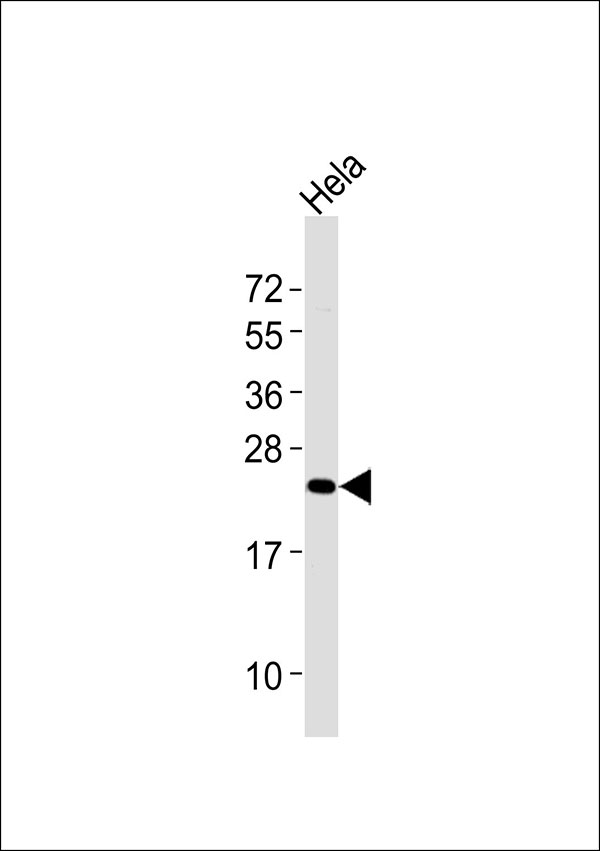Cytoglobin Antibody
Purified Rabbit Polyclonal Antibody (Pab)
- SPECIFICATION
- CITATIONS
- PROTOCOLS
- BACKGROUND

Application
| WB |
|---|---|
| Primary Accession | Q8WWM9 |
| Reactivity | Human, Mouse, Rat |
| Host | Rabbit |
| Clonality | Polyclonal |
| Calculated MW | 21 KDa |
| Antigen Region | 21 - 80 aa |
| Gene ID | 114757 |
|---|---|
| Other Names | Cytoglobin, Histoglobin, HGb, Stellate cell activation-associated protein, CYGB, STAP |
| Target/Specificity | KLH-conjugated synthetic peptide encompassing a sequence within the center region of human Cytoglobin. The exact sequence is proprietary. |
| Dilution | WB~~ 1:1000 |
| Format | 0.01M PBS, pH 7.2, 0.09% (W/V) Sodium azide, Glycerol 50% |
| Storage | Store at -20 °C.Stable for 12 months from date of receipt |
| Name | CYGB (HGNC:16505) |
|---|---|
| Function | Probable multifunctional globin with a hexacoordinated heme iron required for the catalysis of various reactions depending on redox condition of the cell as well as oxygen availability (PubMed:11893755, PubMed:12359339, PubMed:15165856, PubMed:19147491, PubMed:20511233, PubMed:28393874, PubMed:28671819, PubMed:29128400, PubMed:33576020, PubMed:34930834). Has a nitric oxide dioxygenase (NOD) activity and is most probably involved in cell-mediated and oxygen-dependent nitric oxide consumption (PubMed:19147491, PubMed:20511233, PubMed:28393874, PubMed:28671819). By scavenging this second messenger may regulate several biological processes including endothelium-mediated vasodilation and vascular tone (PubMed:19147491, PubMed:28393874). Under normoxic conditions functions as a nitric oxide dioxygenase (NOD) but under hypoxic conditions the globin may switch its function to that of a nitrite (NO2) reductase (NiR), generating nitric oxide (PubMed:29128400). Could also have peroxidase and superoxide dismutase activities, detoxifying reactive oxygen species and protecting cells against oxidative stress (PubMed:12359339, PubMed:33576020, PubMed:34930834). Also binds dioxygen with low affinity and could function as an oxygen sensor but has probably no function as a respiratory oxygen carrier (PubMed:11893755, PubMed:15299006, PubMed:20553503). |
| Cellular Location | Cytoplasm. Nucleus |
| Tissue Location | Widely expressed. Highest expression in heart, stomach, bladder and small intestine. |

Thousands of laboratories across the world have published research that depended on the performance of antibodies from Abcepta to advance their research. Check out links to articles that cite our products in major peer-reviewed journals, organized by research category.
info@abcepta.com, and receive a free "I Love Antibodies" mug.
Provided below are standard protocols that you may find useful for product applications.
Background
May have a protective function during conditions of oxidative stress. May be involved in intracellular oxygen storage or transfer.
References
Burmester T.,et al.Mol. Biol. Evol. 19:416-421(2002).
Asahina K.,et al.Biochim. Biophys. Acta 1577:471-475(2002).
Ota T.,et al.Nat. Genet. 36:40-45(2004).
Mural R.J.,et al.Submitted (JUL-2005) to the EMBL/GenBank/DDBJ databases.
Trent J.T. III,et al.J. Biol. Chem. 277:19538-19545(2002).
If you have used an Abcepta product and would like to share how it has performed, please click on the "Submit Review" button and provide the requested information. Our staff will examine and post your review and contact you if needed.
If you have any additional inquiries please email technical services at tech@abcepta.com.













 Foundational characteristics of cancer include proliferation, angiogenesis, migration, evasion of apoptosis, and cellular immortality. Find key markers for these cellular processes and antibodies to detect them.
Foundational characteristics of cancer include proliferation, angiogenesis, migration, evasion of apoptosis, and cellular immortality. Find key markers for these cellular processes and antibodies to detect them. The SUMOplot™ Analysis Program predicts and scores sumoylation sites in your protein. SUMOylation is a post-translational modification involved in various cellular processes, such as nuclear-cytosolic transport, transcriptional regulation, apoptosis, protein stability, response to stress, and progression through the cell cycle.
The SUMOplot™ Analysis Program predicts and scores sumoylation sites in your protein. SUMOylation is a post-translational modification involved in various cellular processes, such as nuclear-cytosolic transport, transcriptional regulation, apoptosis, protein stability, response to stress, and progression through the cell cycle. The Autophagy Receptor Motif Plotter predicts and scores autophagy receptor binding sites in your protein. Identifying proteins connected to this pathway is critical to understanding the role of autophagy in physiological as well as pathological processes such as development, differentiation, neurodegenerative diseases, stress, infection, and cancer.
The Autophagy Receptor Motif Plotter predicts and scores autophagy receptor binding sites in your protein. Identifying proteins connected to this pathway is critical to understanding the role of autophagy in physiological as well as pathological processes such as development, differentiation, neurodegenerative diseases, stress, infection, and cancer.


